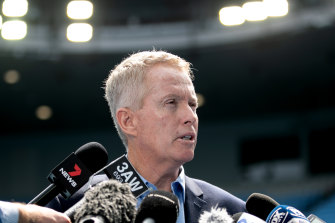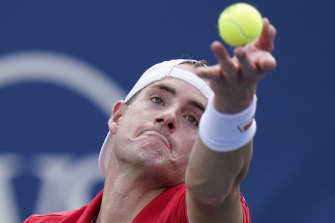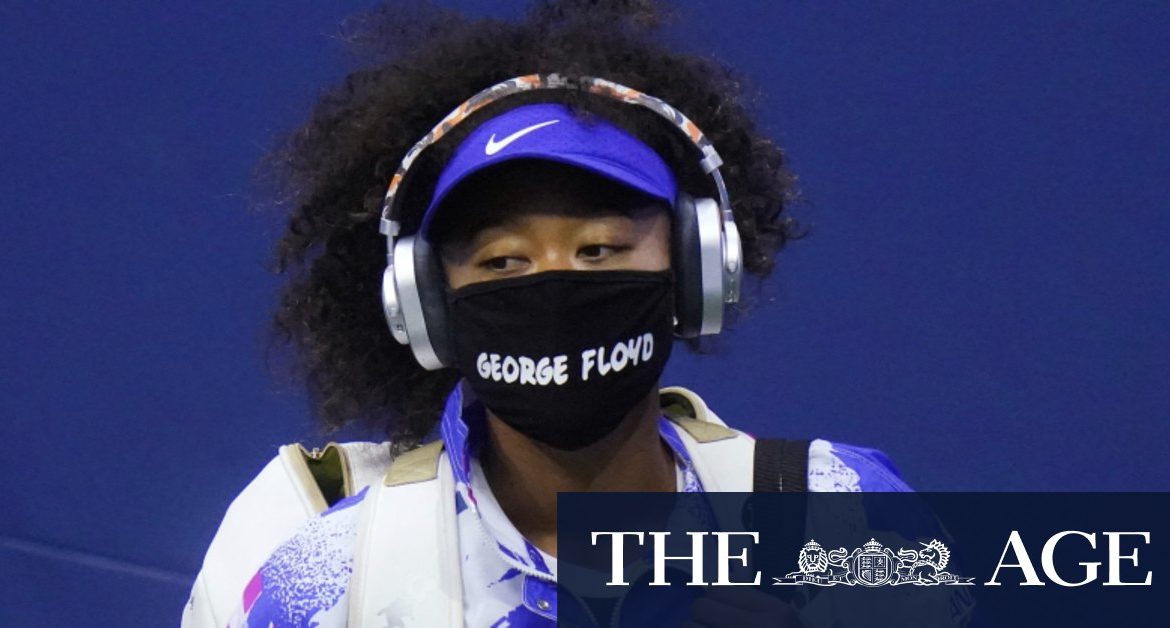Having succeeded in signing up the stars, Australian tennis’ governing body must now turn to the equally stern task of selling the message to Australians – and Victorians specifically – that bringing in more than 1200 players and officials to stage a major international sporting event with a large travelling clientele in the middle of a pandemic is not a foolhardy endeavour.
This time next week, the players and their entourages will begin arriving in Melbourne on 18 chartered planes from seven different cities. They’ll go into mandatory two-week quarantine at a number of inner-city hotels. But unlike ordinary mortals doing hotel quarantine, they will not be cooped up 24 hours a day. They have secured the right to practise and receive treatment during a daily five-hour training block.
The stakes are high. The dispute over whether they could use one particular hotel in central Melbourne, the Westin, shows the Victorian public has a tendency to adopt a “once bitten, twice shy” mentality to importing infection.
The tennis players’ quarantine period comes ahead of the rescheduled Australian Open, which will start on February 8 – a new slot on the calendar arrived at after intricate negotiations between powerful stakeholders.
All this unfolded after Tennis Australia realised it could not deliver on its original hopes for international stars to arrive in early December.
This 2021 tournament will be an Australian Open unlike any we have known. It will be held in February – significantly, outside of the school holiday period, and preceded by qualifying events with full 128-player fields held in the Middle East. It will have five different men’s and women’s tournaments held concurrently at Melbourne Park before the Open, and a significantly reduced crowd capacity. Hanging over all is the lingering threat that COVID-19 may end up meaning the events are entirely spectator-free.
To achieve any of this, Tennis Australia will need to rely heavily on the playing cohort meeting their end of the bargain.
The plans put in place for the Australian Open are elaborate, but amid a series of questions about the rights and wrongs of playing professional sport right now, one stands out: will the players return serve?
Another three years
Tennis Australia and the Victorian government are walking a tightrope on several fronts in running this tournament, and there’s mutual interest in successfully pulling it off.
The state government clings to a tested major events strategy underpinned by big sporting events, and they want a continued return for their multimillion-dollar investment in revamping the Melbourne Park precinct over the past decade.
Already, the government and health authorities’ agreement on the quarantine terms has earned the state a three-year extension to host the prized event until 2039. For them, the risk is that another outbreak could cost the state’s businesses and individuals millions, and the government its reputation as a guardian of public health.
Melbourne Park will not be the same as previous years.
For Tennis Australia, a key risk is the cost. Running a grand slam event during a pandemic is hugely expensive. Estimates suggest the financial hit to TA might be in excess of $100 million. Ratcheting up the bills is the exorbitant cost of organising close to 20 chartered planes and financing the bio-security arrangements.
All this happens as the event itself is expected to deliver less revenue. Broadcasters (and there are a few of them) will be renegotiating their deals and money from ticket sales will be down.
Domestic broadcaster Nine (the owner of this masthead) has received a 10 per cent discount, around $6 million, for 2021 because the changed start date breached their contract and the tournament will crash into their prime-time programming schedule.
The absence of big drawcard Roger Federer, missing from the men’s draw for the first time since 1999, also affects the pulling power of the tournament.
Just think about that for a moment – every other grand slam [is happening where] cases are running wild.
Victorian Premier Daniel Andrews
Tennis Australia has cash reserves of $80 million but it will need financial assistance. At the height of the negotiations, Victorian Treasurer Tim Pallas pledged support to ensure TA’s “ongoing viability”. TA chief executive Craig Tiley has confirmed the body has sought a government loan, supplemented by the private sector, to help the event get off the ground.
At the same time TA, as part of its pitch to the players, pledged that tournament prize money of $71.5 million would not be affected.
Jumping the queue?
The money questions have been an eye-catching part of the pre-tournament positioning, but it’s the precise quarantine conditions – the way in which players are able to travel between their hotels and Melbourne Park to get to practice – that are front of mind for Melburnians. This is a city that will not forget the lockdown experience of 2020 and does not want to repeat it.
Talkback radio, comments on tennis stories posted on social media and letters to the editor have had a strong message in recent weeks, and it’s largely been one-way: why is this Australian Open going ahead at all?
Victorian Premier Daniel Andrews, discussing the balancing act his government has performed, neatly outlined the problem.
“Unlike every other tennis tournament that the men’s and women’s tours will play this year, only the Australian Open is a tennis tournament in a city where it can likely be assumed that those players will bring the virus here,” he said in early December.
“Just think about that for a moment – every other grand slam [is happening where] cases are running wild.”
But TA and the government have been at pains to assure people that tennis players are safe and not dangerous to others and that the quarantine arrangements will be robust.

Tennis Australia boss Craig Tiley. Credit:Tennis Australia
They also insist that they are not queue-jumping to get into Australia while tens of thousands of citizens cannot get a flight. TA boss Tiley has been at pains to stress that bringing in such a large group of people would in no way impact on Victoria’s cap for returned travellers under the hotel quarantine program.
“We’re not impacting the Australians that want to come home and that need to come home and that can come home,” Tiley said just before Christmas.
“Any time if we were going to impact that, of course we wouldn’t do it. So that’s why we’ve taken this position and we’ve worked closely with all forms of government to ensure that Australians can still get home and we can still deliver this event.”
Boosting morale
The tournament’s existence has been questioned at a more existential level this year: why run it this year at all when the cost and the degree of difficulty is so great?
Said Tiley: “Many people have asked the question – why? Why run the Australian Open? And the answer in our minds is in many ways very straightforward.
“We have an opportunity to impact our economy, to boost the psyche of our community and to showcase Melbourne, Victoria and Australia to the rest of the world on how we’ve responded and managed this virus.
“Hopefully 2021 is a year when we transition to a more normal environment for all of us. And we want to make that contribution at the beginning. But we would never do it if there was a risk that would be imposed to the community, to the people of Victoria, and neither would the government.”
Loading
Another experienced tournament official, Kooyong Classic chief Peter Johnston, said tournament administrators across the globe were obliged to “have a go to try and make your event happen” during tough times.
“The end arbiter on whether it goes ahead is the health authorities and the government in every country where this has happened,” Johnston said. “But as an industry, as a business, you’ve really got to do what you can to keep it going.
“I think you lose so much momentum if you miss a year and that’s a real issue. I think Tennis Australia – they’re trying to find a way to maintain continuity so that their sponsors stay with them for the long haul, and the broadcasters.
“I think they’re always in a position where they’ve got to try their best but at the same time you know that the biggest thing is appeasing the public.
“I think ultimately they will be judged if the public stays safe. That’s probably what’s going to be the bottom line for everyone in all this. And that’s why the stakes are still so high coming into this because you just can’t afford to get anything wrong.”
So how will it work?
Organisers are yet to outline specific details about quarantine – including how the players get from their bubbles to the training courts at Melbourne Park, medical treatment and back.
But a few things are known. Concerns from permanent residents at the Westin complex in Collins Street meant that location was abandoned late in the day and another venue had to be found. It’s understood Crown Promenade and the Grand Hyatt will be two of the hotels to host the players and their entourages.
The Victorian government has confirmed that 1100 “residential support officers” have been secured to work on Australian Open arrangements. This is nearly as many support officers as players and officials, suggesting every traveller will have their own dedicated local person to attend to them.
The actions and attitudes of players themselves – the central characters in the whole show – will also count for plenty in Victorians’ attitude to the tournament. Any bubble indiscretions or public complaints about their conditions will dent the public’s goodwill.

Serbia’s Novak Djokovic, centre, poses with volunteers and players after the infamous Adria Tour tournament in Belgrade on June 14.Credit:AP
Victorian authorities will also come down hard on breaches. There’s the threat of $20,000 fines, loss of prize money and even deportation if a player steps out of line.
Tennis bosses, unfortunately, see this as necessary. The attitudes of the world’s leading players to COVID-19 are already on people’s minds, particularly after world No.1 Novak Djokovic infamously organised his own exhibition event, the Adria Tour, in eastern Europe during the sport’s shutdown last year, and he and a number of other players contracted the virus.
Then there’s the curious case of American Sam Querrey, who left Russia on a private jet with his family after his positive test meant he couldn’t take his spot in the field for the St Petersburg Open. After a lengthy investigation by the ATP, Querrey was given what some saw as a light punishment: a $20,000 fine, wholly suspended.
Most recently, America’s top player John Isner gave more than a passing glimpse of his attitude towards COVID-safe measures, freely questioning the value of masks on social media. When challenged, with some advising him to rethink his views and not travel to Australia, one of the sport’s biggest servers doubled down.

John Isner in August.Credit:AP
Isner is well remembered for his part in one of the sport’s most remarkable modern-day moments: the longest match in history, an 11-hour match played across three days at Wimbledon in 2010 when he slugged it out with Nicolas Mahut, the final set finishing 70-68 in Isner’s favour. That match fed the debate about the length of matches and led to some of the grand slams changing their rules about final-set tiebreakers.
It was quite an act of endurance for both players. Now tennis officialdom will have their own test of nerve and sticking power in coming weeks as they cross their fingers and hope that Isner, Djokovic, other players and their entourages behave themselves, and that TA can pull off a successful and largely incident-free Australian summer season.
Scott Spits is a sports reporter for The Age
Most Viewed in Sport
Loading







